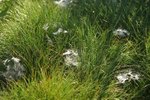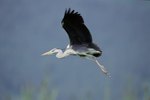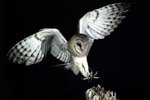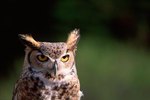
Owl species are divided into two families, with barred owls belonging to the family Strigidae -- known as typical or true owls, and the western barn owl to the family Tytonidae, or barn owl family. There are many differences between the two owls, such as their shape, size and coloring, the calls they make, the way they hunt and the habitats where they live and breed.
Physical Appearance and Flight
Barred owls are large, stocky owls with round faces and a mottled brown and white plumage. The markings on the owls' underparts are mainly vertical brown bars on white, with horizontal bars on their breasts and brown and white barred wings and medium-length tails. Both sexes have identical plumage. They fly, using slow, steady wing beats and occasional long glides.
Barn owls are slim, medium-sized owls with distinctive white, heart-shaped faces, white chests and under wings and a mix of buff and gray on their heads and upper wings. Males are generally paler than females. They have long legs, long, rounded wings and short tails. In flight, barn owls alternate between short flaps and glides.
Calls
Barred owls call with a series of classic hoots and whoo sounds, written as,"who-cooks-for-you? Who-cooks-for-you-all?" They often make a loud, drawn out hoo-waaah that slowly fades away, and it's common to hear two or more barred owls calling to each other.
Barn owls never hoot. Their harsh screeches and rasping calls are unlike any sound made by barred owls or any other owls.
Habitat
Large areas of mature mixed woodland, with large trees, and near water such as streams and swamps, is the preferred habitat of barred owls. In contrast, barn owls need large, open spaces -- marshes, grasslands or agricultural fields -- where they can hunt, and barn owls are rarely far from some form of human habitation.
Hunting
Both owls are nocturnal hunters and prey on small mammals, some reptiles and amphibians, insects, small birds and sometimes fish. It's the way they usually hunt that is different. Barred owls find an elevated perch where they sit and wait -- watching and listening with sharp eyes and ears -- and from their vantage point drop down onto their prey. Sometimes they perch over water to catch fish, and they will wade into shallow water after fish and crayfish. Barn owls hunt in the open, flying low over fields and marshes, following well-used routes by fence lines, hedgerows and woodland edges, and they will cover many miles in a night. With excellent hearing, barn owls can find prey by sound better, not just than barred owls, but any other animal.
Nests and Roosts
Barred owls roost during the day in the trees, perched on branches or hidden in cavities. Their preferred nesting sites are deep hollows about 20 to 40 feet up large trees, and they will use abandoned stick platform nests built by crows, hawks or even squirrels.
Barn owls also roost during the day and sometimes use hollow trees, but they will roost in buildings such as barns and church towers. They often nest where they roost, and lay their eggs in a quiet basin like spot in tree holes, cliff ledges and crevices and all kinds of buildings -- even the Yankee Stadium!
References
- BBC Nature Wildlife: True Owls
- The CornellLab of Ornithology: All About Birds Barred Owl Identification
- National Geographic: Barred Owl
- The CornellLab of Ornithology: All about Birds Barn Owl Indentification
- The CornellLab of Ornithology: All About Birds Barn Owl Life History
- The CornellLab of Ornithology: All About Barred Owl Life History
Photo Credits
-
Jupiterimages/Photos.com/Getty Images




